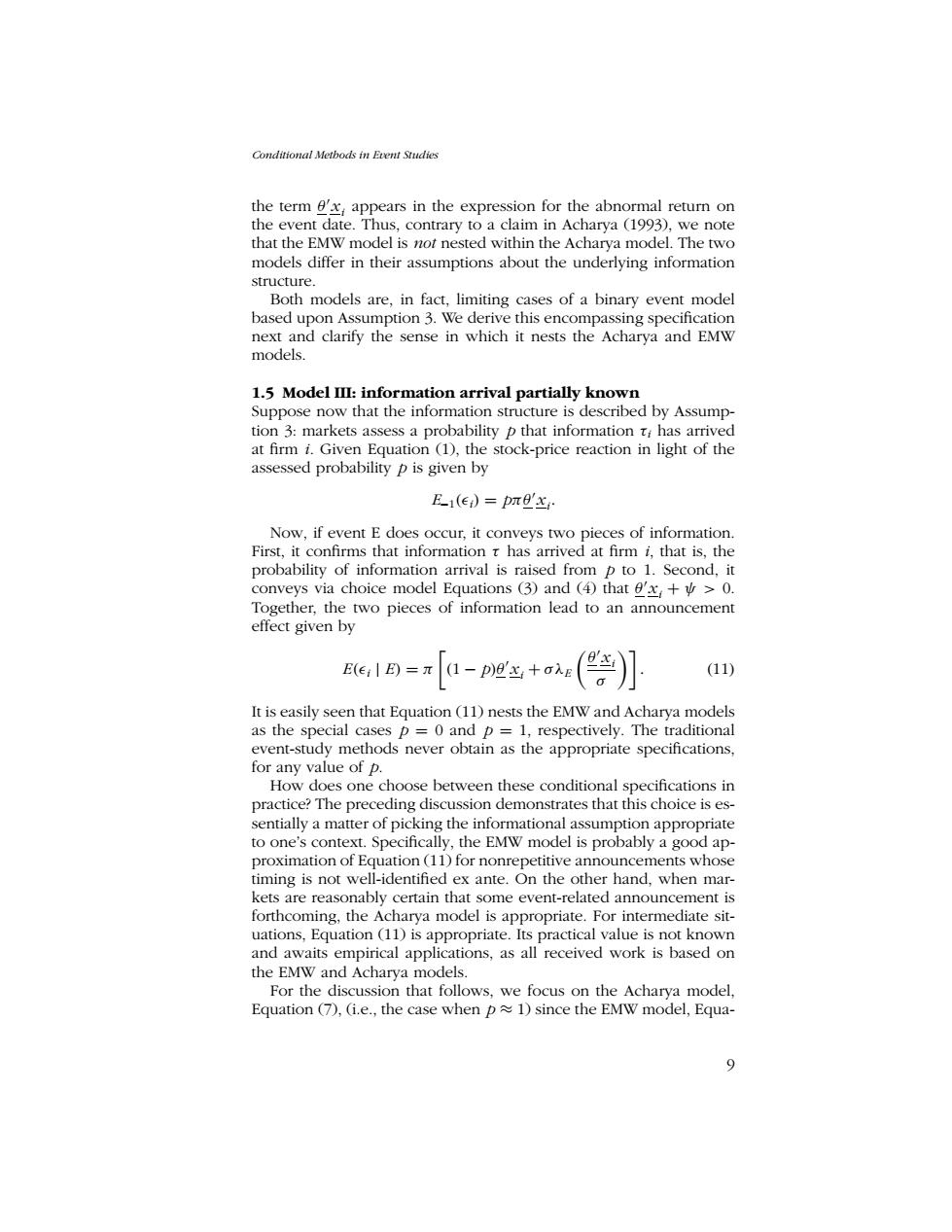正在加载图片...

Conditional Metbods in Event Studies the term 'x,appears in the expression for the abnormal return on the event date.Thus,contrary to a claim in Acharya (1993),we note that the EMW model is not nested within the Acharya model.The two models differ in their assumptions about the underlying information structure. Both models are,in fact,limiting cases of a binary event model based upon Assumption 3.We derive this encompassing specification next and clarify the sense in which it nests the Acharya and EMW models 1.5 Model III:information arrival partially known Suppose now that the information structure is described by Assump- tion 3:markets assess a probability p that information ti has arrived at firm i.Given Equation (1),the stock-price reaction in light of the assessed probability p is given by E(e)=pre'x. Now,if event E does occur,it conveys two pieces of information. First,it confirms that information t has arrived at firm i,that is,the probability of information arrival is raised from p to 1.Second,it conveys via choice model Equations (3)and (4)that 'x+>0. Together,the two pieces of information lead to an announcement effect given by E(e:|E)=π (1-p)'x+a (11) It is easily seen that Equation (11)nests the EMW and Acharya models as the special cases p=0 and p=1,respectively.The traditional event-study methods never obtain as the appropriate specifications, for any value of p. How does one choose between these conditional specifications in practice?The preceding discussion demonstrates that this choice is es- sentially a matter of picking the informational assumption appropriate to one's context.Specifically,the EMW model is probably a good ap- proximation of Equation (11)for nonrepetitive announcements whose timing is not well-identified ex ante.On the other hand,when mar- kets are reasonably certain that some event-related announcement is forthcoming,the Acharya model is appropriate.For intermediate sit- uations,Equation (11)is appropriate.Its practical value is not known and awaits empirical applications,as all received work is based on the EMW and Acharya models. For the discussion that follows,we focus on the Acharya model, Equation (7),(i.e.,the case when p1)since the EMW model,Equa- 9Conditional Methods in Event Studies the term θ0 xi appears in the expression for the abnormal return on the event date. Thus, contrary to a claim in Acharya (1993), we note that the EMW model is not nested within the Acharya model. The two models differ in their assumptions about the underlying information structure. Both models are, in fact, limiting cases of a binary event model based upon Assumption 3. We derive this encompassing specification next and clarify the sense in which it nests the Acharya and EMW models. 1.5 Model III: information arrival partially known Suppose now that the information structure is described by Assumption 3: markets assess a probability p that information τi has arrived at firm i. Given Equation (1), the stock-price reaction in light of the assessed probability p is given by E−1(²i) = pπθ0 xi. Now, if event E does occur, it conveys two pieces of information. First, it confirms that information τ has arrived at firm i, that is, the probability of information arrival is raised from p to 1. Second, it conveys via choice model Equations (3) and (4) that θ0 xi + ψ > 0. Together, the two pieces of information lead to an announcement effect given by E(²i | E) = π · (1 − p)θ0 xi + σ λE µθ0 xi σ ¶¸ . (11) It is easily seen that Equation (11) nests the EMW and Acharya models as the special cases p = 0 and p = 1, respectively. The traditional event-study methods never obtain as the appropriate specifications, for any value of p. How does one choose between these conditional specifications in practice? The preceding discussion demonstrates that this choice is essentially a matter of picking the informational assumption appropriate to one’s context. Specifically, the EMW model is probably a good approximation of Equation (11) for nonrepetitive announcements whose timing is not well-identified ex ante. On the other hand, when markets are reasonably certain that some event-related announcement is forthcoming, the Acharya model is appropriate. For intermediate situations, Equation (11) is appropriate. Its practical value is not known and awaits empirical applications, as all received work is based on the EMW and Acharya models. For the discussion that follows, we focus on the Acharya model, Equation (7), (i.e., the case when p ≈ 1) since the EMW model, Equa- 9